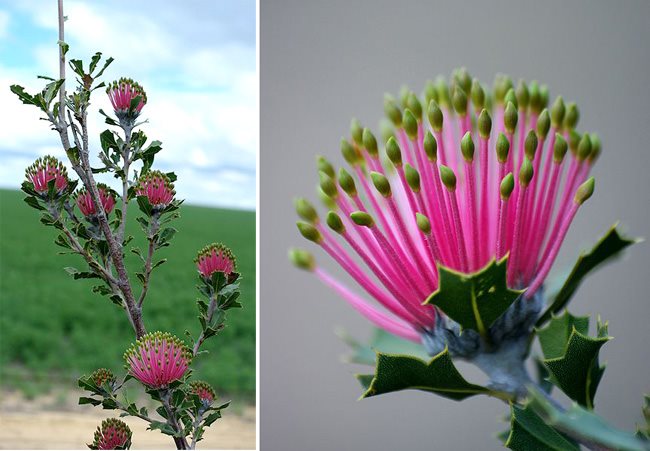Botanic Notables: Banksia
An introduction to the beautiful flowering shrubs and trees of the genus BanksiaAsh and warm winds from an approaching fire are a death knell for many plants, but others have evolved to survive in fire-prone landscapes. Some of these, such as the beautiful flowering shrubs and trees of the genus Banksia, are adapted to even thrive in wildfires.

Banksia coccinea. Photo by: Flickr user OwlCottage.
Many of the eighty Banksia species exhibit heat-sensitive serotiny, which means that the plant will not release its seeds unless it perceives a fire. The rather stubborn Banksia cuneata, for example, will nurture 17,000 seeds for more than twenty years, holding each within its canopy of woody capsules. No fire? No seed release. But, when the plant senses the auspicious sign of a hot autumn fire, it will fill the air with thousands of winged seeds. Swept up in the hot winds, the seeds mingle with ash and blanket the blackened ground.

Banksia ingtegrifolia: seed cones sealed, and open, and in flower (left to right). Photo by: Flickr user Tatters.
Seems nonsensical, doesn't it? It isn't. To the serotinous plant, fire is an ally that will literally level the local competition. In Southwestern Australia, where fires are consummate and reliable, the native Banksia plants can repopulate a previously impenetrable bush with the seeds of their stored seed banks—because the seed release was timed to launch when other plants were not.

Banksia cuneata. Photo by: Gnangarra, Wikipedia Commons.
It is not without its risks—what if a fire does not come? Banksias would sooner perish than open their mature seed capsules in a cool environment, and, many do. What if a fire arrives too soon? Many Banksia species have a somewhat delayed life cycle—they require six years or more to flower, fruit, and seed. So if a wild fire sweeps through in the meantime, the seedless plant will likely die, the last of its lineage.

Banksia coccinea. Illustration by: Ferdinand Bauer (1813).
Meanwhile, those Banksia that do manage to successfully schedule their birth, death, and seed release, are growing in Southern California, Australia, and certain other ecologies where fierce fires can be found.

"The Banksia Men Make a Wicked Plot." Banksia seed cones are the villains in Australia illustrator May Gibb's children's book, Snugglepot and Cuddlepie (1918). The young heros are modeled after Eucalyptus, another Australian native.

Banksia villain in "Snugglepot and Cuddlepie," May Gibbs (1918).

Banksia seed cones are used to make various objects, such as goblets. Photo by: John Lucas.
Anna Laurent is a writer and producer of educational botanical media.
